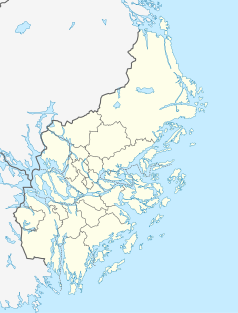Rosersberg
 Rosersberg | |
| Państwo | |
|---|---|
| Region | |
| Gmina | |
| Powierzchnia | 3,12[1] km² |
| Populacja (2018) • liczba ludności • gęstość | |
| Kod pocztowy | 195 xx |
| Portal | |
Rosersberg – miejscowość (tätort) w Szwecji, w regionie administracyjnym (län) Sztokholm (gmina Sigtuna).
W 2018 roku Rosersberg liczył 1815 mieszkańców[2].
Położenie
Miejscowość jest położona w prowincji historycznej (landskap) Uppland, ok. 30 km na północ od centrum Sztokholmu przy linii kolejowej Ostkustbanan (Sztokholm – Sundsvall). Na wschód od Rosersberga przebiega trasa europejska E4. Rosersberg jest jedną ze stacji sztokholmskiego Pendeltågu.
Demografia
Liczba ludności tätortu Rosersberg w latach 1960–2015[3]:
Zabytki i atrakcje turystyczne
Na zachód od miejscowości, w kierunku jeziora Melar, położony jest zamek królewski Rosersberg (Roserbergs slott)[4].
Przypisy
- ↑ a b c Statistiska tätorter 2018; befolkning, landareal, befolkningstäthet (szw.). Statistikmyndigheten SCB, 2020-03-20. [dostęp 2020-09-08]. [zarchiwizowane z tego adresu (2020-03-24)].
- ↑ Statistiska centralbyrån: Befolkning i tätorter 2015-12-31 fördelat på kön och åldersklasser (szw.). [dostęp 2020-09-12].
- ↑ Statistiska centralbyrån: Folkmängd och landareal i tätorter, per tätort. Vart femte år 1960 - 2019 (szw.). [dostęp 2020-09-12].
- ↑ Statens fastighetsverk: Rosersbergs slott (szw.). [dostęp 2020-09-12].
Media użyte na tej stronie
Autor: Brorsson, Licencja: CC BY-SA 3.0
Rosersberg Palace, a royal palace just outside Rosersberg in Sigtuna Municipality, Sweden
Autor: Udo Schröter, Licencja: CC BY-SA 3.0
centrala Rosersberg, Sigtuna kommun, Uppland, Sverige
Autor: Erik Frohne, Licencja: CC BY 3.0
Location map of Stockholm County in Sweden
Equirectangular projection, N/S stretching 197 %. Geographic limits of the map:
- N: 60.30° N
- S: 58.70° N
- W: 17.10° E
- E: 19.50° E
Autor: Lokal_Profil
, Licencja: CC BY-SA 2.5
This coat of arms was drawn based on its blazon which – being a written description – is free from copyright. Any illustration conforming with the blazon of the arms is considered to be heraldically correct. Thus several different artistic interpretations of the same coat of arms can exist. The design officially used by the armiger is likely protected by copyright, in which case it cannot be used here.
Individual representations of a coat of arms, drawn from a blazon, may have a copyright belonging to the artist, but are not necessarily derivative works.








